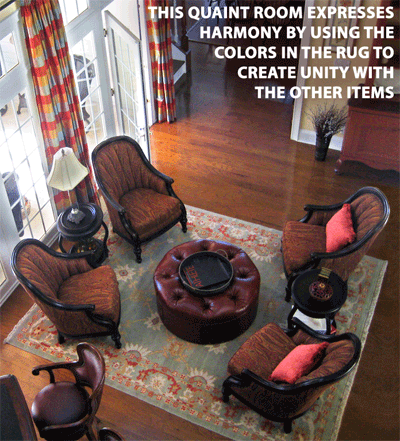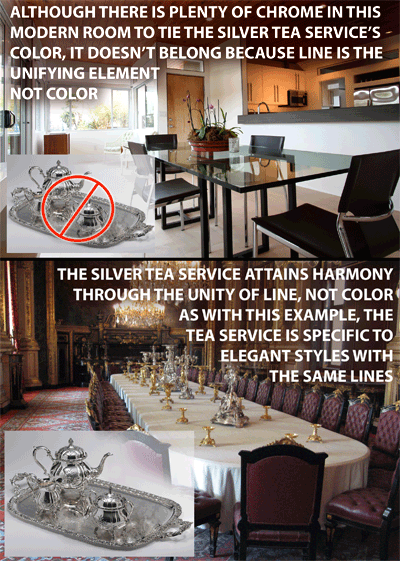|
|
|
|
|
|
|
|
|
|
|
|
|
|
|
|
|
|
|
|
|
|
|
|
|
|
|
Article Twelve: Principles of Design 101B - Unity Part 1
|
|
|
|
|
|
|
|
|
|
|
|
|
|
|
|
|
From my last article, I know you'll look at furniture sizes a little differently. Today, our featured Principle of Design is unity. I'll present unity in two articles - unity of harmony, which we'll cover now and unity of rhythm will be covered in my next article. This quick guide, along with my other articles, will give you a new way of looking at tea sets.
|
|
|
|
|
- Unity: It's not hard to identify things in a room that interfere with the sense of unity - you know it because they clearly don't belong. Every element in a room should relate to each other in some way. They may have color, pattern or texture in common. Or, the lines of the furniture may be in “harmony”, where the pieces feel like they add to one another. One way to establish unity is to feature one major style or theme in a room. If you do incorporate items from other styles, they should relate to the major pieces somehow - again, either through a color, a pattern, a texture or a line.
- Harmony describes unity of mood and is achieved by using pieces that share the same Elements of Design
. Repetition creates harmony as with patterns, colors or lines. This is evident in the fabric of soft furnishings. An example of fabric harmony is when the Draperies, the sofa and chairs are made from the same fabric.
|
|
 |
|
|
|
|
|
|
|
|
|
|
|
 |
|
|
|
|
|
An example of disharmony, that decorators disavow, is the placing of an elegant silver tea service within a casual eating area - it clearly doesn't fit. Some might think that changing the hardware on the cabinets to nickel-plated, would "tie in" the silver finish of the tea set to the room - but it won't.
Color and texture are not the problems in this case, line is. The formality of the tea service's lines, are just not harmonious with the casualness of the eating area.
What would work with our lovely tea service? It would be much more at home in a Victorian-influenced formal dining room setting. This is called establishing unity through line or achieving unity of line by putting the tea set in with similarly formal and elegant furniture.
Remember, lines can be curvy.
|
|
|
|
|
|
|
Experiment with relating room elements to each other.
See you in part 2. Happy Home Staging and Styling.
|
|
|
|
|
|
|
|
|
© 2021 |
|
 |
|
|
|
|
|
|
|
|
|
|
|
|
|



